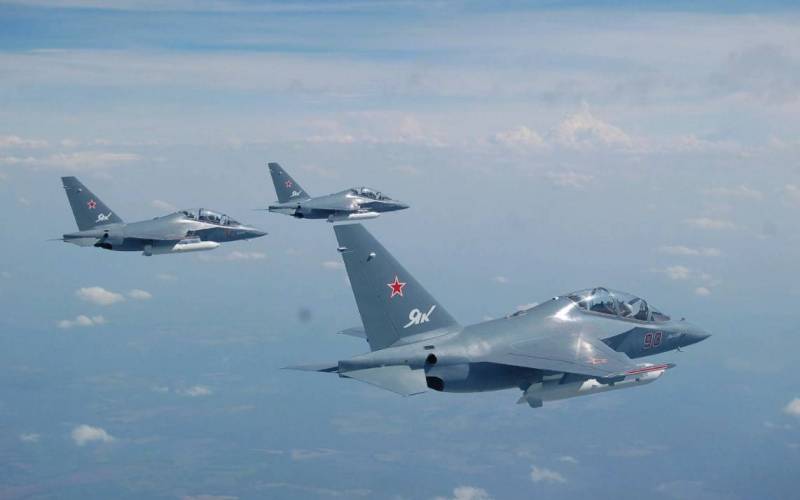NWO experience: attack aircraft will have to learn to interact with unmanned aerial vehicles
The explicit desire of President Lukashenko to establish the production of Su-25 attack aircraft in Belarus causes an ambiguous attitude. On the one hand, Old Man is a fine fellow, who pulls everything that is possible into his hut. On the other hand, a logical question arises, hasn't the age of attack aviation in the form as we know it ended in principle?
WWII experience
The very concept of attack aviation was formed during the Great Patriotic War, when the success of its actions largely depended on whether Victory would be achieved over the most dangerous enemy and at what cost. It was necessary to storm ground targets to support the infantry even from conventional fighters, sharpened for dogfights, and bombers, which led to corresponding losses. The result of understanding the bloody combat experience was the appearance of the Il-2 attack aircraft, or "reinforced concrete aircraft", as the Germans themselves called it for the difficulty in destroying it.
In total, about 36 thousand of these "flying tanks" were assembled, which made this attack aircraft the most massive combat aircraft in the history of aviation. IL-2 made a serious contribution to the defeat of the Wehrmacht, however, in 1956, attack aircraft were temporarily abolished altogether. This decision was connected with the advent of tactical nuclear weapons, which should have changed a lot in the event of a real use. Also influenced by the fact that the combat capabilities of Soviet fighters, which could carry more weapons, increased significantly. However, in the mid-60s, the concepts of warfare between the USSR and the USA underwent a change again. Both sides came to the conclusion that a large-scale nuclear war is not beneficial to anyone, and instead of it there will be local conflicts where conventional weapons should be used.
During the Dnepr exercises in 1967, it turned out that it was difficult for Soviet fighters to hit ground targets with their high speed. So, again there was a request for a full-fledged attack aircraft. In the competition with the Il-102, the Su-25, also known as the Grach, won. This is a subsonic armored attack aircraft designed for direct support of ground forces over the battlefield day and night with direct line of sight of the target, as well as the destruction of objects with given coordinates around the clock in any weather conditions. "Rooks" entered service in 1981 and remain there to this day. The Su-25 carries a wide range of different weapons and has been used in many conflicts, including the Syrian campaign.
NWO experience
We have to admit that during the special operation "Rooks" cannot fully reveal their strike potential. The reason is the oversaturation of the Armed Forces of Ukraine with various MANPADS, as well as the presence of quite serious modern air defense systems in the enemy, which together makes the actions of Russian aviation extremely difficult. Our attack helicopters, front-line bombers and attack aircraft suffer losses when they find themselves in the zone of action of the enemy's air defense.
Alas, Ukraine, armed by the NATO bloc, is not at all “barmaley” moving through the deserts in their machine-gun pickups. A logical question arises: did the era of attack aviation end with the NWO?
Apparently, it really ended in the form in which it is commonly perceived. It is obvious that directing the Su-25 to fortified positions, from where several missiles from MANPADS of the Stinger type can simultaneously take off towards, is a game with death for the pilot, who is the most valuable element in the aircraft. It is no less obvious that in conditions of a glut of the front with various air defense systems, the main emphasis should be placed precisely on unmanned aircraft. Drones of all types are needed - reconnaissance, reconnaissance-strike, shock and purely kamikaze - in commercial quantities. However, this conclusion does not mean that there is no more work for a professional air attack aircraft, on the contrary.
At the moment, it seems appropriate to bet not on the resumption of production of obsolete Su-25s, but on increasing the production of Yak-130 light combat training aircraft. This is a compact two-seat modern aircraft that can be used both for training fourth and fifth generation fighter pilots and as a light attack aircraft. It can be applied in several ways at once.
At first, the Yak-130 can be the lead aircraft from which the slave drones will be controlled. The co-pilot of an attack aircraft can be controlled by UAVs of the Orion and Okhotnik types, which will conduct reconnaissance, give target designation, deliver air strikes, and correct rocket and artillery fire.
Secondly, The Yak-130 itself can be turned into an attack drone, which has a serious speed, combat load and survivability during shelling from the ground, which is ensured by the design features of the attack aircraft and its unmanned crew.
Thirdly, Yak-130 can be used as an enemy drone hunter. Thanks to its speed and the presence of air-to-air missiles, it will be able to catch up with Ukrainian UAVs and destroy them in the air. Perhaps this particular attack aircraft will be able to act as a carrier for Russian kamikaze drones of the Lancet type for the so-called air mining. Upon detecting an approaching enemy drone, the attack aircraft could release several Lancets in loitering mode, which would rush towards it at speeds up to 300 km / h and blow up together.
In general, the most promising so far seems to be the development of attack aircraft in this direction.

Information